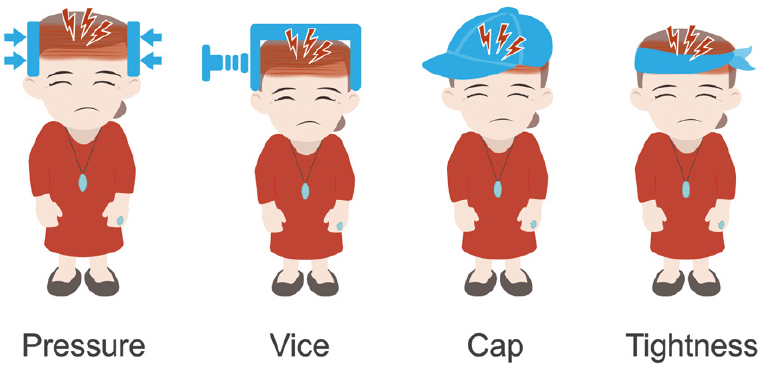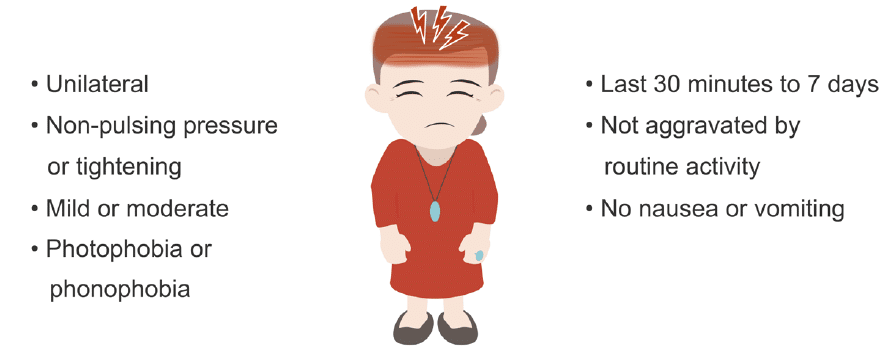Tension headache
Diagnosing tension headaches
Tension headaches are the most common type of primary headache disorder seen in practice, and perhaps the most misunderstood.
The name implies that muscle tension or anxious tension is the cause, but this is not accurate. Tension-type headache is not related to over-contracted muscles or anxiety—the mechanism is an abnormality in neuronal modulation of the trigeminal nerve.
The trigeminal nerve carries the sensory input from the face and cranium to the central nervous system and connects to the muscles of the head and vicinity.
The trigeminal nerve is involved in the relationship between the central pathways that facilitate pain in the trigeminal nucleus and the pain nociceptors in the cranial structures – blood vessels, mucus membranes, and pericranial muscles.
Activated nocioceptors in the pericranial tissues, including the bone and meninges, send signals to the brain that are interpreted as pain.
Tension headaches are often bilateral, and are described by patients as pressure-like, vice-like, cap-like or merely as a tightness. In general, this sensation is experienced around the whole head, including the forehead and back of the head.

The intensity of tension headaches can vary, but it is rarely severe, and generally, they are not aggravated by activity.
Diagnostic criteria for tension headaches
There are four key criteria that must be met for a diagnosis of tension headache:
- The headache typically lasts from 30 minutes to seven days.
- The headaches have at least two of the following four characteristics. They are:
- bilateral
- have a pressing or tightening (non-pulsating) quality
- mild or moderate intensity
- not aggravated by routine physical activity such as walking or climbing stairs
- There must be no nausea or vomiting, and while photophobia or phonophobia may occur, it must not be both.
- These headaches are not better accounted for by another International Classification of Headache Disorders 3rd edition diagnosis or any other reasonable cause.
You may find pericranial tenderness with palpation around the cranium in tension-type headaches. And, you may need to differentiate trigger points in the temporalis or suboccipital muscles from other cranial structures
There is a close association between tension headaches and migraines. In fact, these two types of headaches often occur together and you should use the criteria listed above to exclude the possibility of a migraine

Subtypes of tension headaches
There are three subtypes of tension headaches, differentiated by their frequency:
- Infrequent tension-type headaches occur about once a month, but less than 12 days a year.
- Frequent tension-type headaches present with at least 10 episodes of headache per month for > 3 months.
- Chronic tension-type headaches evolve from frequent tension-type headaches and present with > 15 headache days per month.
This is an edited excerpt from the Medmastery course Headache Masterclass by Robert Coni, DO, EdS, FAAN. Acknowledgement and attribution to Medmastery for providing course transcripts.
- Coni R. Headache Masterclass. Medmastery
- Coni R. Clinical Neurology Essentials. Medmastery
- Simmonds GR. Neurology Masterclass: Managing Common Diseases. Medmastery
- Simmonds GR. Neurology Masterclass: Managing Emergencies. Medmastery
References
- The International Classification of Headache Disorders 3rd edition
- Kaniecki RG. Tension-type headache. Continuum (Minneap Minn). 2012 Aug;18(4):823-34.
Neurology Library: The primary headache disorders
- Coni R. Deconstructing headache classification. LITFL
- Coni R. Headache aetiology. LITFL
- Coni R. Migraine headache. LITFL
- Coni R. Tension headache. LITFL
- Coni R. Cluster headache. LITFL
- Coni R. Trigeminal autonomic cephalalgias. LITFL
- Coni R. Other primary headaches. LITFL
- Coni R. Chronic daily headaches. LITFL
Neurology Library
Robert Coni, DO, EdS, FAAN. Vascular neurologist and neurohospitalist and Neurology Subspecialty Coordinator at the Grand Strand Medical Center in South Carolina. Former neuroscience curriculum coordinator at St. Luke’s / Temple Medical School and fellow of the American Academy of Neurology. In my spare time, I like to play guitar and go fly fishing. | Medmastery | Linkedin |
BMBS (The University of Nottingham) BMedSci (The University of Nottingham). Emergency Medicine RMO at Sir Charles Gairdner Hospital Perth, WA. Interested in Medical Education and Emergency Medicine. Swimmer and frequent concert attendee.


